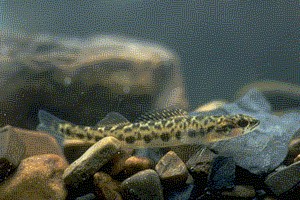Leopard darter facts for kids
Quick facts for kids Leopard darter |
|
|---|---|
 |
|
| Conservation status | |
| Scientific classification | |
| Synonyms | |
|
Hadropterus pantherinus Moore & Reeves, 1955 |
The leopard darter (Percina pantherina) is a small, freshwater fish. It belongs to the darter group, which is part of the family called Percidae. This family also includes fish like perches.
This special fish lives only in the United States. You can find it in the Little River area in Oklahoma and Arkansas. Leopard darters like to live in medium to large streams. These streams usually have lots of rocks and boulders on the bottom.
Leopard darters eat tiny water bugs and other small creatures. They lay their eggs mostly in March and April. Sadly, this fish is in danger. Its home is being lost because of dams, pollution from farms, and other human activities. The leopard darter has never been a very common fish. It has been listed as a threatened species since 1978. The International Union for Conservation of Nature also calls it a "vulnerable species".
Contents
What Does the Leopard Darter Look Like?
Leopard darters are small fish. They usually grow to be less than three inches (about 8 cm) long. They have 11 to 14 big, dark spots on their sides. These spots stand out against a lighter body color. Their back is a pale olive green, and their belly is yellowish-olive. The back of the fish also has many dark stripes and bars.
Leopard Darter Life Cycle and Habits
Most leopard darters live for less than two years. However, some have been found to live longer than three years.
Reproduction: Laying Eggs
Leopard darters lay their eggs, a process called spawning, in March and April. Sometimes, they might start as early as February. They choose shallow, fast-moving parts of the stream called riffles. These riffles have gravel bottoms. The female fish lays her eggs, and they are buried in the gravel. On average, a female lays about 65 eggs at a time. Young leopard darters, called juveniles, start to appear in May each year.
What Do Leopard Darters Eat?
Leopard darters mainly eat small aquatic insects. They also feed on tiny crustaceans that live in the water.
Where Do Leopard Darters Live?
Leopard darters prefer medium to large streams. You usually won't find them in very small streams that are close to the source of a river. From May to February, they like to stay in small, calm pools. These pools have a bottom made of rubble and boulders. When it's time to lay eggs, they move to gravel areas. However, the stream bottom in general can be gravel, rubble, boulders, or even solid rock.
Where Are Leopard Darters Found?
Historically, the leopard darter lived in the higher parts of large streams. These streams were all part of the Little River system in Oklahoma and Arkansas. Today, you can still find small groups of them in these areas.
In Oklahoma, they live in the Little River system. This includes the Mountain Fork, Glover, and Little Rivers. These rivers are in LeFlore, McCurtain, and Pushmataw Counties. In Arkansas, leopard darters are found in the Cossatot, Robinson Fork, and Mountain Fork Rivers. These are in Howard, Polk, and Sevier Counties.
Why Is the Leopard Darter in Danger?
Leopard darters have probably never been a very common fish. The biggest danger to them is the loss of their habitat. This happens when dams are built, creating large lakes called reservoirs. These dams destroy the fast-flowing stream habitats that darters need. Dams also separate different groups of darters, making it harder for them to survive.
Other threats include logging activities near streams. Runoff from farms and factories also pollutes the water. Removing gravel from rivers for construction also harms their homes. All these activities put the leopard darter at risk.


